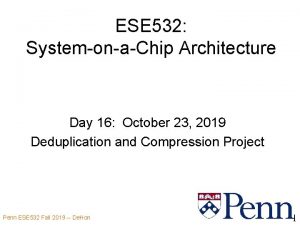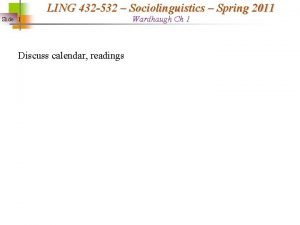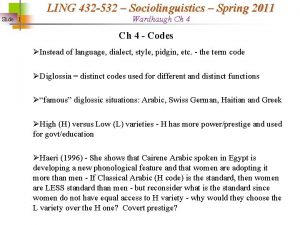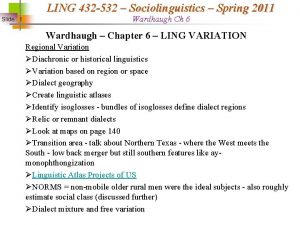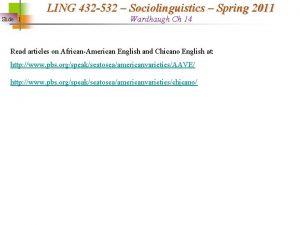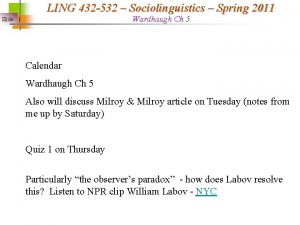LING 432 532 Sociolinguistics Spring 2011 Slide 1










- Slides: 10

LING 432 -532 – Sociolinguistics – Spring 2011 Slide 1 Wardhaugh Ch 8 Wardhaugh – Chapter 8 – CHANGE Language Change ØNot all variation that shows a relationship with age of speaker is change - age grading (when a certain group adopts a ling form but drops it later in life) ØAge grading hard to distinguish from change ØNeed real time data = trend study resamples the same community at 2 different points in time (What I did with Labov’s Philadelphia study) ØPanel study re-interviews the same subjects later in life to see if they have changed from http: //www. ling. upenn. edu/~gillian/PAPERS/Sankoff. Age, AT, RT. pdf

LING 432 -532 – Sociolinguistics – Spring 2011 Slide 2 Wardhaugh Ch 8 Wardhaugh – Chapter 8 – CHANGE Language Change ØApparent time = an analysis of the data that proposes lingusitic variation which shows a relationship with age projects that this is change. That is, if younger speakers are using more of a variant than older speakers, this represents change. Presupposes stability of individual’s ling systems (an 80 year old speaker represents how people spoke when he/she acquired the dialect roughly 60 years earlier) from http: //www. ling. upenn. edu/~gillian/PAPERS/Sankoff. Age, AT, RT. pdf

LING 432 -532 – Sociolinguistics – Spring 2011 Slide 3 Wardhaugh Ch 8 Wardhaugh – Chapter 8 – CHANGE Labov, Martha’ Vineyard 1963 ØSee http: //coral. lili. uni-bielefeld. de/~ttrippel/labov/node 5. html Ø 2 variables (ay) and (aw) as in high and how ØFinds that there is change in progress - backs this up with previous data from LANE ØFindings show that there is not a monotonic relationship with age (higher use of variant increases as age of speaker decreases) ØIt is the middle-aged speakers with highest centralization ØAlso, the fishing-related areas highest centralization ØFinally, directly shows that attitude toward the island is the reason behind use of a ling form that symbolically links them to the island - strong connection between ling variation and identity!

LING 432 -532 – Sociolinguistics – Spring 2011 Slide 4 Wardhaugh Ch 8 Wardhaugh – Chapter 8 – CHANGE Labov ØConnects prestige with the LMC and use of hypercorrection ØAlso with women (being socially the second highest social group with respect to gender) ØChanges are related to prestige ØChange from above the level of consciousness vs. below are different ØThere are many connections between gender, class and change

LING 432 -532 – Sociolinguistics – Spring 2011 Slide 5 Wardhaugh Ch 8 Wardhaugh – Chapter 8 – CHANGE Trudgill, Norwich ØShows connections between working class forms and non-standard use ØWomen use more overt prestige forms ØIn self-reports, men overreport their non-standard use and women underreport ØTrudgill’s restudy of Norwich shows that real time trend study shows things not predicted by previous study (1988)

LING 432 -532 – Sociolinguistics – Spring 2011 Slide 6 Wardhaugh Ch 8 Wardhaugh – Chapter 8 – CHANGE Milroys ØShow that network strength keeps change from affecting tight networks ØLooser networks show more use of outside forms ØLinguistic marketplace - different interactions based on jobs will affect person’s position in language change situation

LING 432 -532 – Sociolinguistics – Spring 2011 Slide 7 Wardhaugh Ch 8 Wardhaugh – Chapter 8 – CHANGE The Process of Change Ø Change from below - led by interior social classes (LMC and UWC) and by women ØLabov’s Philadelphia study support this - different systems for black and white speakers ØEckert’s study of Jocks and Burnouts - girls range was wider than boys; burnouts associated with Detroit so more advanced in Northern Cities Shift

LING 432 -532 – Sociolinguistics – Spring 2011 Slide 8 Wardhaugh Ch 8 Wardhaugh – Chapter 8 – CHANGE The Process of Change ØLexical Diffusion - sound change spreads 1 word at a time - S-shaped curve in time - see p. 220 - every word has its own history ØLexical diffusion and wave theory similar - how change spreads through language/community (wave theory shown by changes in different geographic space in England - (r) versus (STRUT) p. 140) ØSome sound change is regular and all sounds are changing in every phonetic environment ØSome sound change has exceptions - mad, bad, glad and swam, ran and began in Philly

LING 432 -532 – Sociolinguistics – Spring 2011 Slide 9 Wardhaugh Ch 8 Wardhaugh – Chapter 8 – CHANGE The Process of Change ØLexical diffusion versus regular (Neogrammarian) sound change ØTwo types of sound change: 1 is that it is phonetically regular and predictable - although certain environments may promote/inhibit the change ØLexical diffusion states that each word that contains the sound change is affected individually ØReality is that the more common sound change is regular, while lexical diffusion does also play a factor (plaid) ØNew theories about word frequency shows that there is more to this than originally thought - Exemplar theory (Joan Bybee)

LING 432 -532 – Sociolinguistics – Spring 2011 Slide 10 Wardhaugh Ch 8 Conn 2005 The Process of Change ØI replicated Labov’s Philadelphia study to test his ideas about language variation and change ØLet’s look at NWAV presentations









